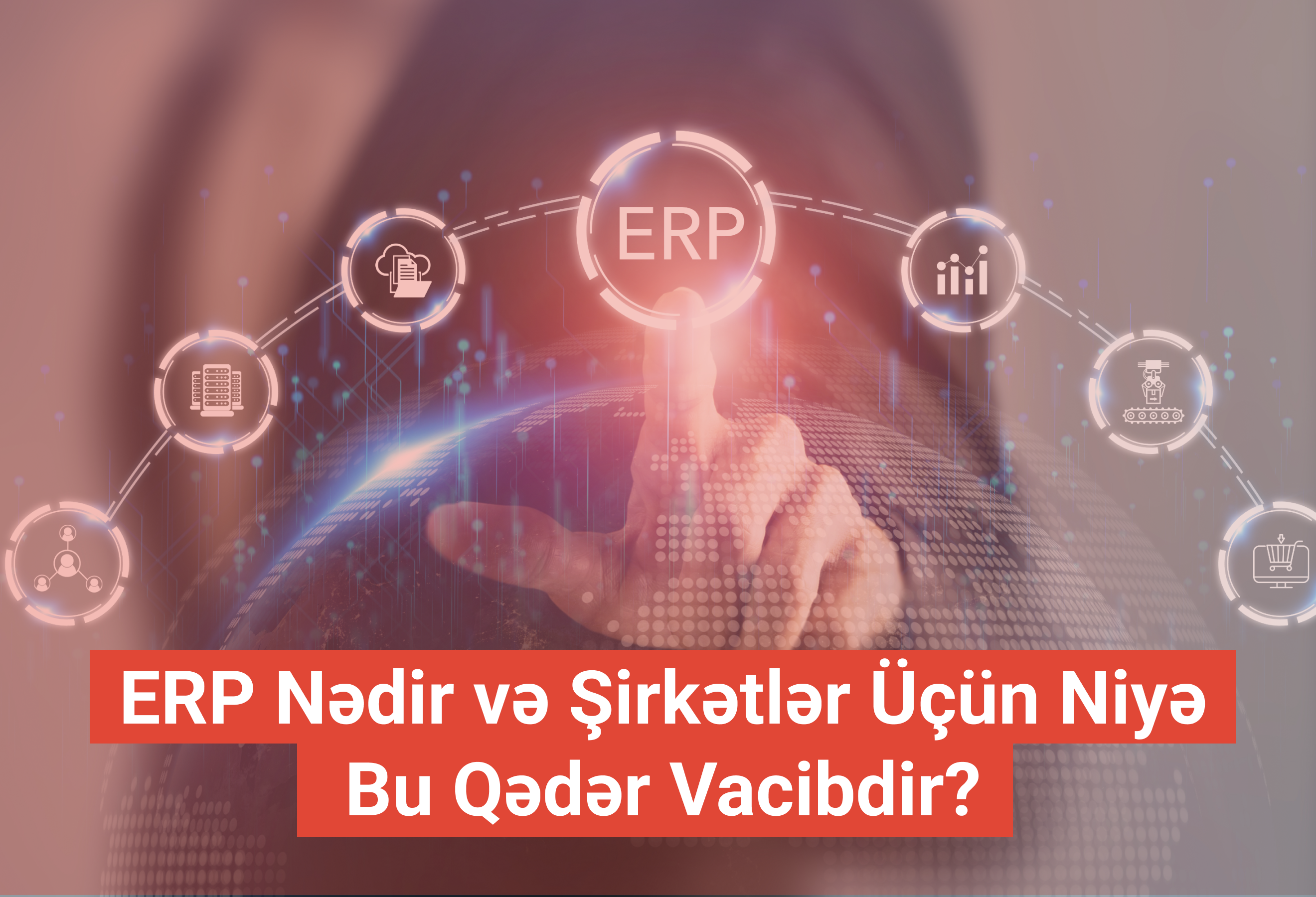
06/05/2023
Bugünkü sürətli və rəqabətli biznes dünyasında təşkilatların uğur qazanması üçün sadəcə mövcudluqlarını qoruması kifayət deyil – onlar həm də daha ağıllı qərarlar qəbul etməli və dəyişikliklərə çevik reaksiya verməlidirlər. Bu nöqtədə real vaxtda məlumat analizi ön plana çıxır. Bu üsul, məlumatların toplandığı andan etibarən dərhal işlənməsi və təhlil olunması ilə şirkətlərə dəyərli məlumatlar təqdim edir və qərarverməni sürətləndirir.
ERP sistemləri şirkətlərin gündəlik fəaliyyətlərini – sifarişlərin işlənməsi, maliyyə idarəetməsi, anbar nəzarəti və insan resursları kimi – effektiv şəkildə idarə etmələrinə kömək edən proqram təminatlarıdır. ERP platformaları müəssisə daxilindəki müxtəlif şöbələrdən gələn məlumatları vahid sistemdə topladığı üçün məlumatlara real vaxtda çıxışı və analiz imkanını asanlaşdırır. Bununla yanaşı, ERP sistemləri təkrarlanan prosesləri avtomatlaşdırır, səhvləri azaldır və şöbələrarası əməkdaşlığı gücləndirir.
ERP sistemləri ilə real vaxtda məlumat analizi birlikdə işlədikdə, şirkətlərə əhəmiyyətli rəqabət üstünlüyü qazandırır. Təşkilatlar bazar dəyişikliklərinə daha çevik uyğunlaşa, proseslərdəki qeyri-effektivlikləri aşkarlaya, xərcləri azalda və müştəri məmnuniyyətini artıraraq daha uğurlu fəaliyyət göstərə bilərlər.
Bu bloqda öyrənəcəksiniz:
ERP sistemlərində real vaxtda məlumat analizinin üstünlükləri
Bu analizin uğurla tətbiqi üçün strategiyalar
ERP sistemlərində real vaxt analizində qarşıya çıxan çətinliklərin həlli yolları
Gəlin başlayıq!
ERP Sistemlərində Real Vaxtda Məlumat Analizinin Üstünlükləri
Daha dəqiq və sürətli qərarlar
Real vaxtda analiz şirkətlərə ən son və düzgün məlumatlara çıxış imkanı verir. Bu isə daha çevik və məlumatlara əsaslanan qərarların qəbuluna səbəb olur. Nəticədə şirkətlər bazar dəyişiklərinə vaxtında reaksiya verir, inkişaf fürsətlərini görür və potensial riskləri qabaqlayır.
Əməliyyatların anlıq izlənməsi və məhsuldarlığın artması
ERP sistemləri müəssisələrə əməliyyatlarını real vaxtda izləməyə imkan verir. Bu sayədə problemlər tez müəyyən edilir və dərhal tədbir görülür. Resursların effektiv istifadəsi və proseslərin optimallaşdırılması isə ümumi məhsuldarlığı artırır.
Müştəri məmnuniyyəti və loyallığının güclənməsi
ERP və real vaxt analizi birlikdə şirkətlərə müştərilərlə fərdiləşdirilmiş və anında qarşılıqlı əlaqə qurmağa imkan verir. Müştəri davranışları və ehtiyacları barədə real vaxt məlumatları əsasında daha uyğun məhsul və xidmətlər təklif oluna bilər.
Xərclərin azaldılması və ehtiyatların düzgün bölüşdürülməsi
ERP sistemləri ehtiyat səviyyələri və resurs istifadəsi haqqında anlıq məlumat təqdim etdiyi üçün müəssisələr israfı azalda və daha dəqiq planlama edə bilirlər.
Rəqabət üstünlüyü
Trendləri və bazar imkanlarını rəqiblərdən əvvəl görmək üçün real vaxt məlumatları böyük üstünlük yaradır. Bu da müəssisəyə çeviklik və liderlik qazandırır.
ERP-də Real Vaxt Analizinin Tətbiqi Üçün Strategiyalar
1. Doğru ERP sisteminin seçilməsi
Əvvəlcə şirkətin ölçüsünə, fəaliyyət sahəsinə, büdcəsinə və analitik ehtiyaclarına uyğun ERP sistemi seçilməlidir. Seçdiyiniz sistem real vaxt analizi funksiyalarını dəstəkləməlidir.
2. Məlumat toplama və inteqrasiya imkanları
Məlumatların real vaxtda analiz edilə bilməsi üçün müxtəlif mənbələrdən – sensorlar, IoT cihazları və digər sistemlərdən – inteqrasiya olunması vacibdir.
3. Məlumat keyfiyyəti və idarəetməsi
Effektiv analiz üçün məlumatların dəqiq və ardıcıl olması əsasdır. Məlumatların təmizlənməsi, normallaşdırılması və təsdiqlənməsi üçün prosedurlar müəyyənləşdirilməlidir.
4. Əməkdaşların maarifləndirilməsi və təlimi
ERP sisteminin uğurla istifadəsi üçün işçilərə bu texnologiyanın faydaları izah edilməli, sistemin işləmə prinsipləri öyrədilməlidir. Bu, tətbiqə qarşı müqavimətin qarşısını alır.
5. Əməkdaşlıq və kommunikasiya mədəniyyətinin təşviqi
ERP sistemindən tam səmərə əldə etmək üçün müxtəlif şöbələr arasında məlumat paylaşımı və birgə qərarvermə təşviq olunmalıdır.
ERP Sistemlərində Real Vaxt Analizi: Çətinliklər və Onların Həlli
Məlumatların təhlükəsizliyi və məxfiliyi
Real vaxt analizində həssas məlumatlarla işləmək lazım gəlir. Bu səbəbdən məlumat şifrələnməsi, giriş nəzarəti və digər təhlükəsizlik tədbirləri tətbiq edilməlidir.
Texniki çətinliklər
Sistemlərin uyğunluğu və performansı real vaxt analizində kritik rol oynayır. Zəruri hallarda əlavə proqram və avadanlıq yatırımları da tələb oluna bilər.
Dəyişikliklərə müqavimət
İşçilər yeni sistemə keçid zamanı narahatlıq və müqavimət göstərə bilər. Bu halların qarşısını almaq üçün dəyişikliklərin səbəbi izah olunmalı, kifayət qədər təlim təmin edilməlidir.
Məhdudiyyətlərin idarə olunması
Real vaxt analiz sistemi qurmaq və saxlamaq maliyyət tələb edir. Şirkət öz ehtiyaclarını və gözləntilərini qiymətləndirməli, bu sərmayənin dəyərini düzgün hesablamalıdır.




